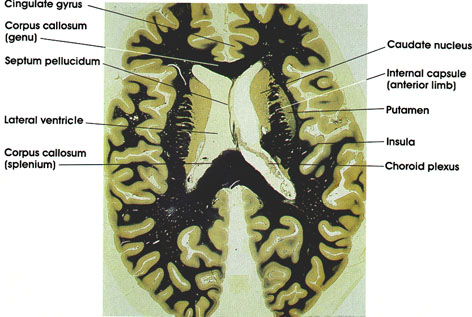

Plate 17.352 Basal Ganglia
Ronald A. Bergman, Ph.D., Adel K. Afifi, M.D., Paul M. Heidger,
Jr., Ph.D.
Peer Review Status: Externally Peer Reviewed

Human, 10% formalin, Weigert's hematoxylin (Loyez), 1 x.
Cingulate gyrus: Located dorsal to the corpus callosum. A component of the limbic lobe, which also includes the subcallosal gyrus, isthmus, parahippocampal gyrus and uncus.
Caudate nucleus: C-shaped mass of gray matter closely related to the lateral ventricle. A component of the basal ganglia and thus plays a role in motor control.
Internal capsule (anterior limb): Separates the caudate nucleus and cerebral cortex.
Putamen: One of the basal ganglia nuclei. Located lateral to the anterior limb of the internal capsule. Concerned with motor control.
Insula: Also referred to as the island of Reil, lies deep in the sylvian fissure. Concerned with autonomic function.
Choroid plexus: Vascular pial fold in the body of the lateral ventricle. One of the sites of formation of cerebrospinal fluid.
Corpus callosum: C-shaped bundle of heavily myelinated fibers connecting the two cerebral hemispheres. Important in interhemispheric transfer of information. Section is through the genu (anterior) and splenium (posterior) parts of the corpus callosum.
Lateral ventricle: Note the characteristic bulge of the caudate into the cavity of the lateral ventricle.
Septum pellucidum: Separates the two lateral ventricles. May contain a cavity, cavurn septi pellucidi.
Next Page | Previous Page | Section Top | Title Page
Please send us comments by filling out our Comment Form.
All contents copyright © 1995-2025 the Author(s) and Michael P. D'Alessandro, M.D. All rights reserved.
"Anatomy Atlases", the Anatomy Atlases logo, and "A digital library of anatomy information" are all Trademarks of Michael P. D'Alessandro, M.D.
Anatomy Atlases is funded in whole by Michael P. D'Alessandro, M.D. Advertising is not accepted.
Your personal information remains confidential and is not sold, leased, or given to any third party be they reliable or not.
The information contained in Anatomy Atlases is not a substitute for the medical care and advice of your physician. There may be variations in treatment that your physician may recommend based on individual facts and circumstances.
URL: http://www.anatomyatlases.org/